Abstract
Oxytocin produces uterine contractions and milk ejection, functions related to parturition and nuturing. Studies were conducted to determine if this peptide, native to the brain and the posterior pituitary gland, plays a role in the induction of maternal behavior. Intact virgin female rats were given 0.4 μg of oxytocin, 0.4 μg of [Arg8]vasopressin, or saline through lateral ventricular cannulae. Forty-two percent of intact rats receiving oxytocin displayed full maternal behavior towards foster pups. None of the saline- or vasopressin-treated animals displayed full maternal behavior. Criteria in five behavioral categories had to be fulfilled by an animal within 2 hr of injection for its behavior to be considered fully maternal. When partial maternal responses were considered, oxytocin was significantly more effective than saline and marginally more effective than vasopressin. Five animals responding fully maternally after oxytocin injection were allowed to stay with pups for 10 days. All five continued to display full maternal behavior during this time. Nearly all animals that responded fully maternally to oxytocin injection were in the last day of diestrus or in proestrus or estrus. This suggested that elevated or recently elevated levels of estrogen may be necessary for the induction of full maternal behavior by oxytocin. Twenty-seven virgin female rats were ovariectomized and given either 100 μg of estradiol benzoate per kg in oil subcutaneously or oil alone immediately after operation. Forty-eight hours later, all animals received 0.4 μg of oxytocin intracerebroventricularly. Eleven of 13 estrogen-primed animals became fully maternal; none of 14 nonprimed animals became fully maternal.
Keywords: neurohypophysis, vasopressin, peptides, estrogen dependence
Full text
PDF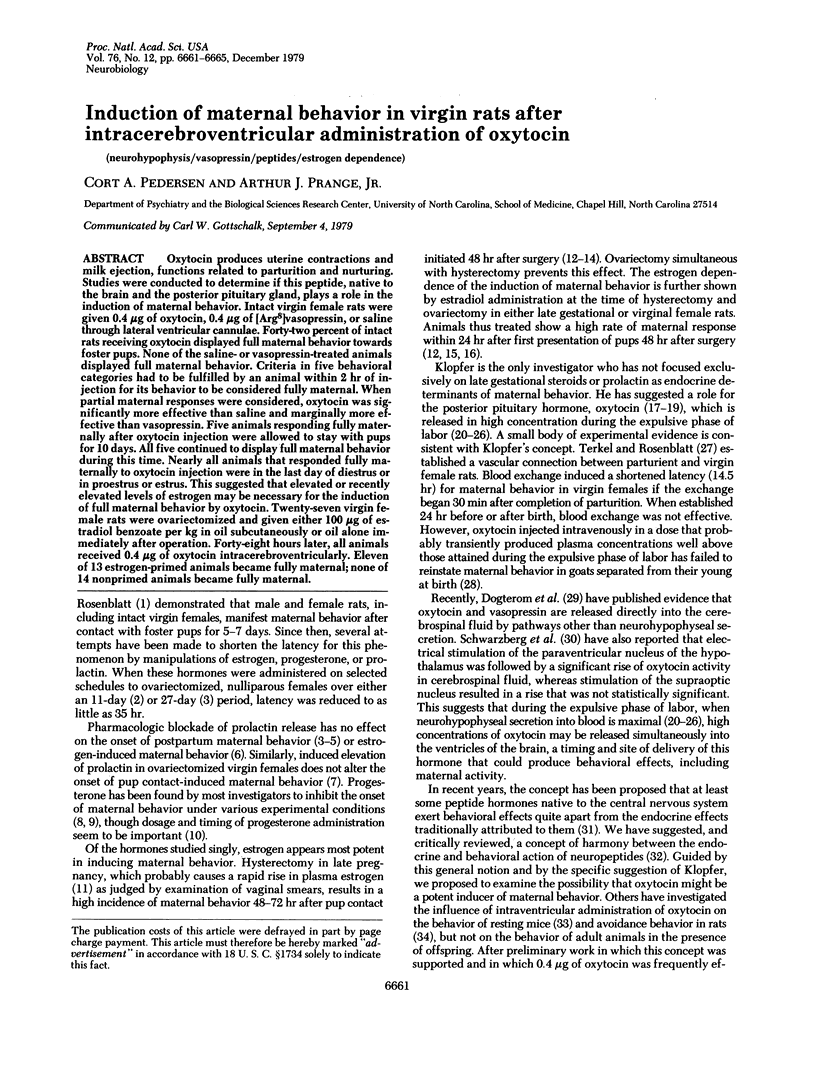
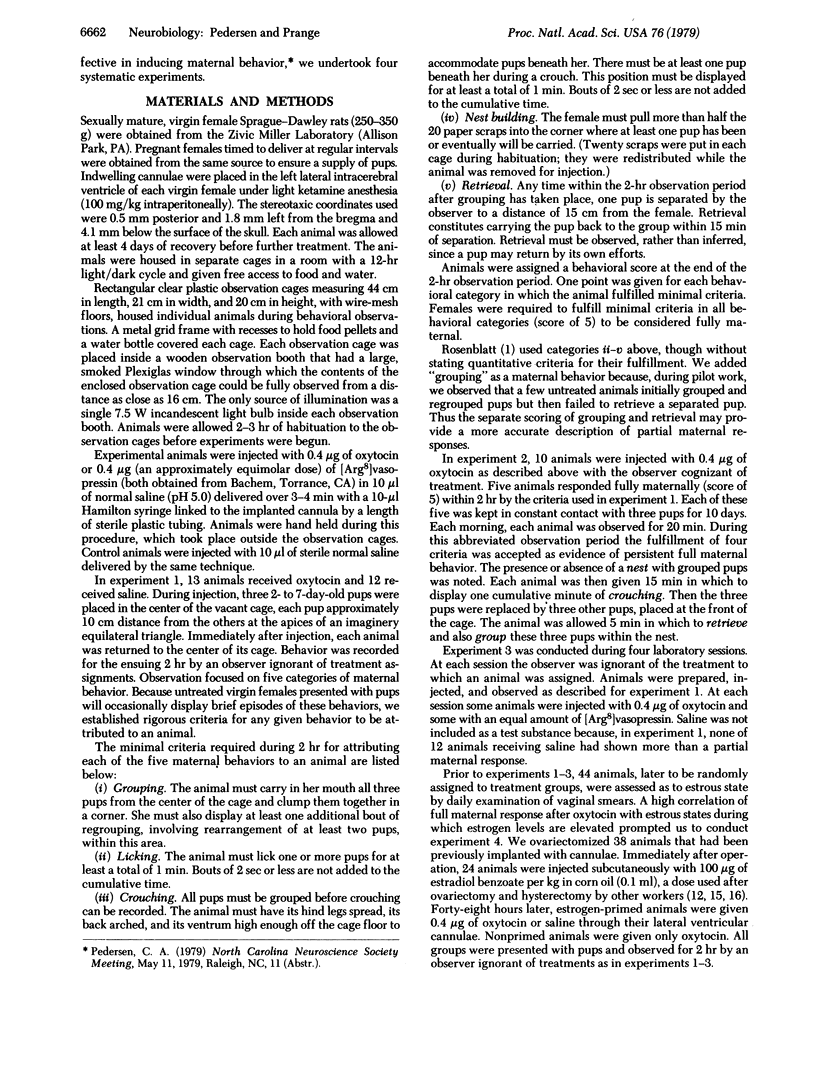
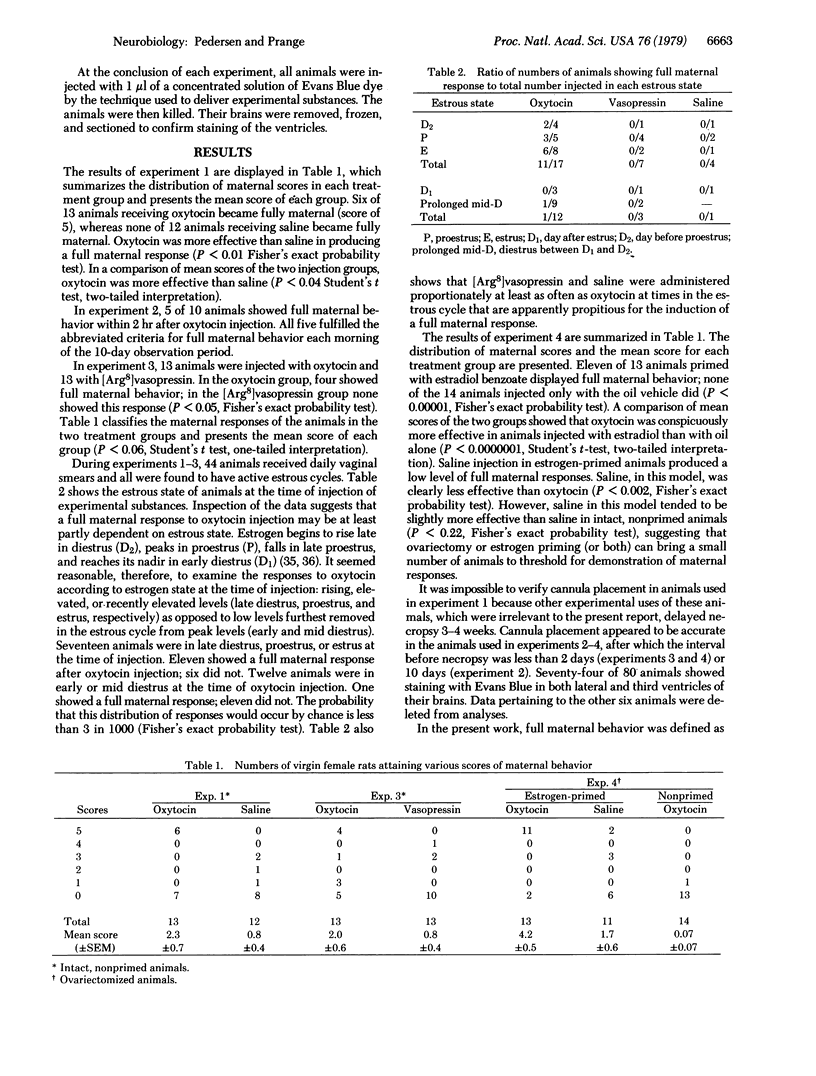
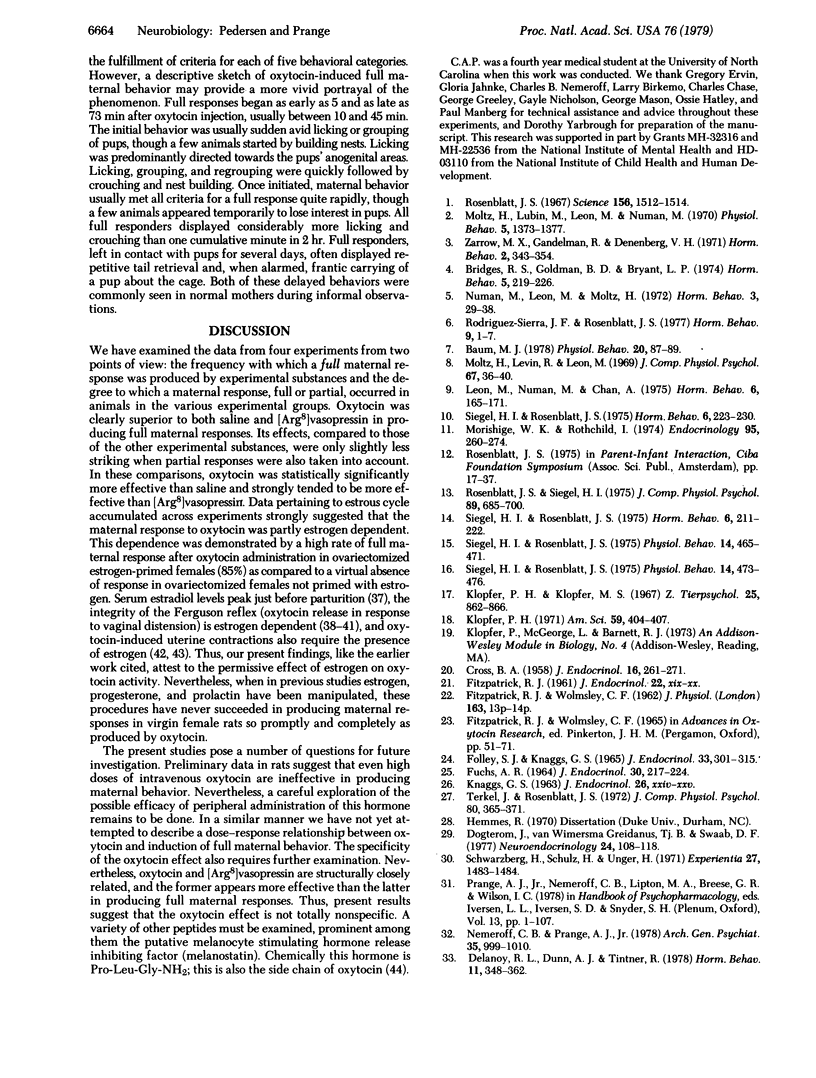
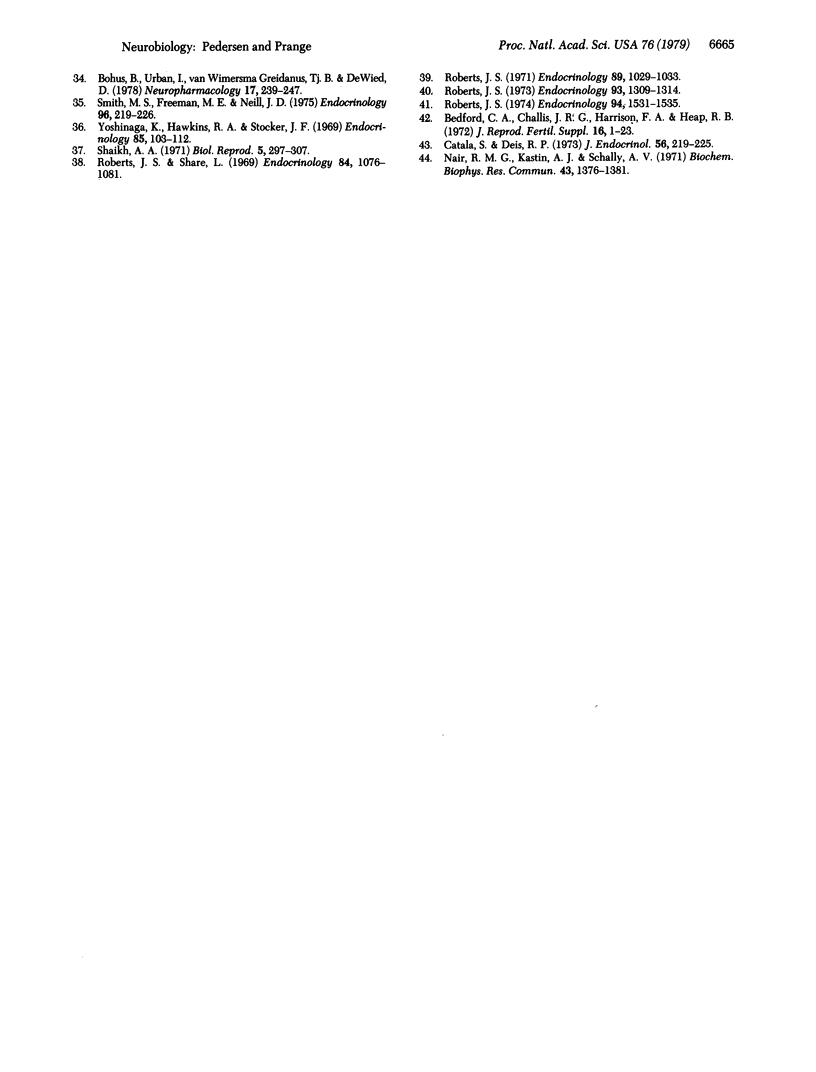
Selected References
These references are in PubMed. This may not be the complete list of references from this article.
- Baum M. J. Failure of pituitary transplants to facilitate the onset of maternal behavior in ovariectomized virgin rats. Physiol Behav. 1978 Jan;20(1):87–89. doi: 10.1016/0031-9384(78)90207-x. [DOI] [PubMed] [Google Scholar]
- Bohus B., Urban I., van Wimersma Greidanus T. B., de Wied D. Opposite effects of oxytocin and vasopressin on avoidance behaviour and hippocampal theta rhythm in the rat. Neuropharmacology. 1978 Apr-May;17(4-5):239–247. doi: 10.1016/0028-3908(78)90107-7. [DOI] [PubMed] [Google Scholar]
- Bridges R. S., Goldman B. D., Bryant L. P. Serum prolactin concentrations and the initiation of maternal behavior in the rat. Horm Behav. 1974 Sep;5(3):219–226. doi: 10.1016/0018-506x(74)90030-0. [DOI] [PubMed] [Google Scholar]
- CROSS B. A. On the mechanism of labour in the rabbit. J Endocrinol. 1958 Feb;16(3):261–276. doi: 10.1677/joe.0.0160261. [DOI] [PubMed] [Google Scholar]
- Catalá S., Deis R. P. Effect of oestrogen upon parturition, maternal behaviour and lactation in ovariectomized pregnant rats. J Endocrinol. 1973 Feb;56(2):219–225. doi: 10.1677/joe.0.0560219. [DOI] [PubMed] [Google Scholar]
- Delanoy R. L., Dunn A. J., Tintner R. Behavioral responses to intracerebroventricularly administered neurohypophyseal peptides in mice. Horm Behav. 1978 Dec;11(3):348–362. doi: 10.1016/0018-506x(78)90037-5. [DOI] [PubMed] [Google Scholar]
- Dogterom J., Van Wimersma Greidanus T. B., Swabb D. F. Evidence for the release of vasopressin and oxytocin into cerebrospinal fluid: measurements in plasma and CSF of intact and hypophysectomized rats. Neuroendocrinology. 1977;24(2):108–118. doi: 10.1159/000122702. [DOI] [PubMed] [Google Scholar]
- FUCHS A. R. OXYTOCIN AND THE ONSET OF LABOUR IN RABBITS. J Endocrinol. 1964 Sep;30:217–224. doi: 10.1677/joe.0.0300217. [DOI] [PubMed] [Google Scholar]
- Folley S. J., Knaggs G. S. Levels of oxytocin in the jugular vein blood of goats during parturition. J Endocrinol. 1965 Oct;33(2):301–315. doi: 10.1677/joe.0.0330301. [DOI] [PubMed] [Google Scholar]
- Klopfer P. H. Mother love: what turns it on? Am Sci. 1971 Jul-Aug;59(4):404–407. [PubMed] [Google Scholar]
- Leon M., Numan M., Chan A. Adrenal inhibition of maternal behavior in virgin female rats. Horm Behav. 1975 Jun;6(2):165–171. doi: 10.1016/0018-506x(75)90032-x. [DOI] [PubMed] [Google Scholar]
- Moltz H., Levin R., Leon M. Differential effects of progesterone on the maternal behavior of primiparous and multiparous rats. J Comp Physiol Psychol. 1969 Jan;67(1):36–40. doi: 10.1037/h0026654. [DOI] [PubMed] [Google Scholar]
- Moltz H., Lubin M., Leon M., Numan M. Hormonal induction of maternal behavior in the ovariectomized nulliparous rat. Physiol Behav. 1970 Dec;5(12):1373–1377. doi: 10.1016/0031-9384(70)90122-8. [DOI] [PubMed] [Google Scholar]
- Morishige W. K., Rothchild I. Temporal aspects of the regulation of corpus luteum function by luteinizing hormone, prolactin and placental luteotrophin during the first half of pregnancy in the rat. Endocrinology. 1974 Jul;95(1):260–274. doi: 10.1210/endo-95-1-260. [DOI] [PubMed] [Google Scholar]
- Nair R. M., Kastin A. J., Schally A. V. Isolation and structure of hypothalamic MSH release-inhibition hormone. Biochem Biophys Res Commun. 1971 Jun 18;43(6):1376–1381. doi: 10.1016/s0006-291x(71)80026-8. [DOI] [PubMed] [Google Scholar]
- Nemeroff C. B., Prange A. J., Jr Peptides and psychoneuroendocrinology. A perspective. Arch Gen Psychiatry. 1978 Aug;35(8):999–1010. doi: 10.1001/archpsyc.1978.01770320093009. [DOI] [PubMed] [Google Scholar]
- Numan M., Leon M., Moltz H. Interference with prolactin release and the maternal behavior of female rats. Horm Behav. 1972 Mar;3(1):29–38. doi: 10.1016/0018-506x(72)90004-9. [DOI] [PubMed] [Google Scholar]
- Roberts J. S. Divergent effects of infused progesterone on the reflexive release of oxytocin in ovariectomized goats variously treated with 17beta-estradiol. Endocrinology. 1974 Jun;94(6):1531–1535. doi: 10.1210/endo-94-6-1531. [DOI] [PubMed] [Google Scholar]
- Roberts J. S. Functional integrity of the oxytocin-releasing reflex in goats: dependence on estrogen. Endocrinology. 1973 Dec;93(6):1309–1314. doi: 10.1210/endo-93-6-1309. [DOI] [PubMed] [Google Scholar]
- Roberts J. S. Seasonal variations in the reflexive release of oxytocin and in the effect of estradiol on the reflex in goats. Endocrinology. 1971 Oct;89(4):1029–1033. doi: 10.1210/endo-89-4-1029. [DOI] [PubMed] [Google Scholar]
- Roberts J. S., Share L. Effects of progesterone and estrogen on blood levels of oxytocin during vaginal distention. Endocrinology. 1969 May;84(5):1076–1081. doi: 10.1210/endo-84-5-1076. [DOI] [PubMed] [Google Scholar]
- Rodriguez-Sierra J. F., Rosenblati J. S. Does prolactin play a role in estrogen-induced maternal behavior in rats: apomorphine reduction of prolactin release. Horm Behav. 1977 Aug;9(1):1–7. doi: 10.1016/0018-506x(77)90044-7. [DOI] [PubMed] [Google Scholar]
- Rosenblatt J. S. Nonhormonal basis of maternal behavior in the rat. Science. 1967 Jun 16;156(3781):1512–1514. doi: 10.1126/science.156.3781.1512. [DOI] [PubMed] [Google Scholar]
- Rosenblatt J. S., Siegel H. I. Hysterectomy-induced maternal behavior during pregnancy in the rat. J Comp Physiol Psychol. 1975 Sep;89(7):685–700. doi: 10.1037/h0077052. [DOI] [PubMed] [Google Scholar]
- Schwarzberg H., Schulz H., Unger H. Der Oxytocingehalt im Liquor cerebrospinalis wacher Kaninchen nach elektrischer Stimulation liquorraumnaher Kerngebiete. Experientia. 1971 Dec 15;27(12):1483–1484. doi: 10.1007/BF02154306. [DOI] [PubMed] [Google Scholar]
- Shaikh A. A. Estrone and estradiol levels in the ovarian venous blood from rats during the estrous cycle and pregnancy. Biol Reprod. 1971 Dec;5(3):297–307. doi: 10.1093/biolreprod/5.3.297. [DOI] [PubMed] [Google Scholar]
- Siegel H. I., Rosenblatt J. S. Estrogen-induced maternal behavior in hysterectomized-overiectomized virgin rats. Physiol Behav. 1975 Apr;14(04):465–471. doi: 10.1016/0031-9384(75)90012-8. [DOI] [PubMed] [Google Scholar]
- Siegel H. I., Rosenblatt J. S. Hormonal basis of hysterectomy-induced maternal behavior during pregnancy in the rat. Horm Behav. 1975 Sep;6(3):211–222. doi: 10.1016/0018-506x(75)90008-2. [DOI] [PubMed] [Google Scholar]
- Siegel H. I., Rosenblatt J. S. Latency and duration of estrogen induction of maternal behavior in hysterectomized-ovariectomized virgin rats: effects of pup stimulation. Physiol Behav. 1975 Apr;14(04):473–476. doi: 10.1016/0031-9384(75)90013-x. [DOI] [PubMed] [Google Scholar]
- Siegel H. I., Rosenblatt J. S. Progesterone inhibition of estrogen-induced maternal behavior in hysterectomized-ovariectomized virgin rats. Horm Behav. 1975 Sep;6(3):223–230. doi: 10.1016/0018-506x(75)90009-4. [DOI] [PubMed] [Google Scholar]
- Smith M. S., Freeman M. E., Neill J. D. The control of progesterone secretion during the estrous cycle and early pseudopregnancy in the rat: prolactin, gonadotropin and steroid levels associated with rescue of the corpus luteum of pseudopregnancy. Endocrinology. 1975 Jan;96(1):219–226. doi: 10.1210/endo-96-1-219. [DOI] [PubMed] [Google Scholar]
- Terkel J., Rosenblatt J. S. Humoral factors underlying maternal behavior at parturition: corss transfusion between freely moving rats. J Comp Physiol Psychol. 1972 Sep;80(3):365–371. doi: 10.1037/h0032965. [DOI] [PubMed] [Google Scholar]
- Yoshinaga K., Hawkins R. A., Stocker J. F. Estrogen secretion by the rat ovary in vivo during the estrous cycle and pregnancy. Endocrinology. 1969 Jul;85(1):103–112. doi: 10.1210/endo-85-1-103. [DOI] [PubMed] [Google Scholar]


